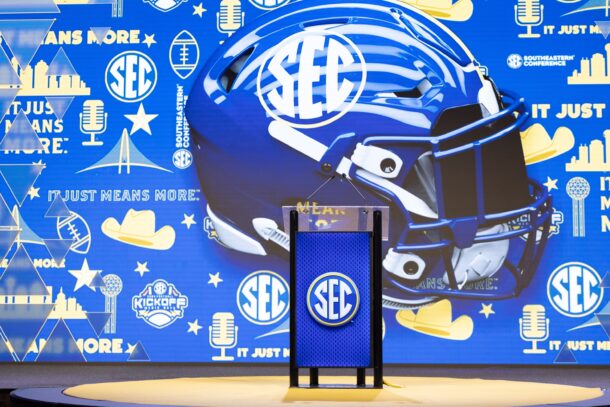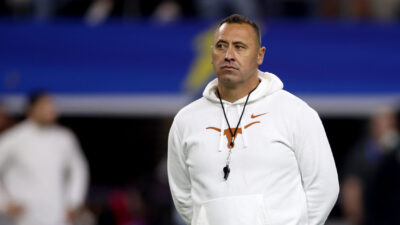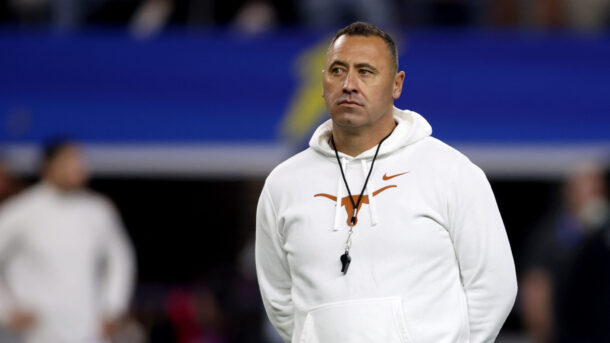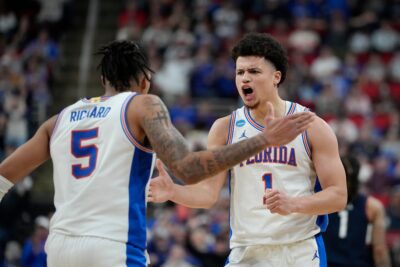Ad Disclosure
The LSU Tigers knocked off Big Ten heavyweight Wisconsin in Houston on Saturday by orchestrating a 17-point comeback. After re-watching the game, here are five things we learned.
1. The run defense needs work. Yes, Melvin Gordon is good. And the outcome may have been different if an apparent hip agitation didn’t limit him to three second-half carries. Give him credit for great vision and acceleration.
But LSU got out of position too many times. The Tigers often fell for play fakes, failed to react to pre-snap realignments and didn’t stay disciplined. In the first quarter, Kwon Alexander bit on an excellent play fake from quarterback Tanner McEvoy even though defensive end Jermauria Rasco held containment and had McEvoy bottled up. Tight end Sam Arneson cleared Jalen Mills out of the play on the left side, the Badgers offensive line executed and Gordon bounced outside for a 20-yard run.
On the next play, Reggie Love sprinted into motion before the snap on an end-around. McEvoy executed another deceptive play fake to running back Corey Clement, and Alexander again zooms at an angle toward the mesh point anticipating a handoff. Defensive end Danielle Hunter takes an identical path in the same gap, catching his foot on Alexander and falling. Arneson again blocks Mills downfield and fullback Derek Watt takes out Tre’Davious White. D.J. Welter can’t quite catch Love, resulting in a 45-yard touchdown run.
The longest Wisconsin pass of the game, 14 yards to Alex Erickson, was a dump-and-run that originated in the backfield. Erickson got free when Arneson cleared out White.
Again, credit some excellent Wisconsin blocking and Gordon’s elite skills, but LSU will face plenty of special running backs in the SEC West. The Tigers must learn to avoid hero ball, with each defender staying at home and handling his own responsibilities, and the fast, athletic linebackers and defensive backs must avoid getting blocked at the second and third level.
2. The secondary played well in coverage. Granted, Wisconsin’s McEvoy gave the Tigers help. By the end of the game, McEvoy flinched and then flung the ball downfield to no one in particular every time a defender got within five yards of him. But earlier in the game, Wisconsin’s receivers struggled to get any separation. McEvoy made a handful of strong, decently-placed throws that fell incomplete because LSU’s secondary draped a man on the intended receiver, including Dwayne Thomas’ key pass breakup while covering Love in the fourth quarter that helped the Tigers stall Wisconsin near midfield.
McEvoy gets partial blame for the two interceptions, but Mills and Ronald Martin showed excellent athleticism and ball skills.
It’s a limited sample size and LSU will face better quarterback-receiver combos later this season, but the Tigers graded out well on the initial test.
3. Leonard Fournette didn’t get many good opportunities. On one fourth-quarter pitch, Anthony Jennings left Fournette to hang with multiple Wisconsin defenders steaming toward him behind the line of scrimmage. On a first-quarter handoff, Wisconsin’s defense got penetration, and though Fournette found the small seam that developed, the play gained two yards. There were a few carries where it appeared Fournette was intent on bouncing outside and crashing into defenders rather than following his blockers, and that didn’t work well. But overall, Fournette didn’t get many chances with space to maneuver.
4. Don’t chum the water for LSU. Saturday’s fourth quarter reminded me of a good boxing match or UFC fight. As soon as the Tigers noticed they’d stunned Wisconsin, LSU pressed forward and launched a flurry of punches until the Badgers toppled. With Wisconsin missing two starting defensive linemen, LSU instituted a three-receiver set. The Badgers aligned with two down linemen. The result? Kenny Hilliard had a virtual 1-on-1 with Wisconsin defensive back Peniel Jean (and half the width of the field, and a 15-yard gap between the players.)
As McEvoy’s pass attempts decayed into panicked back-foot prayers, LSU sent pressure from all angles. Wisconsin faced third-and-10 from near midfield with less than seven minutes to play, for example, and Mills rocketed into McEvoy’s legs from the quarterback’s left, forcing an early off-target throw that ended a promising drive. A play earlier, McEvoy bailed and looped a desperation pass in spite of Gordon’s textbook blitz pickup.
With Gordon (hip injury) a non-factor in the fourth quarter and Wisonsin’s defensive line ailing, LSU focused on unraveling McEvoy and bullying the Badgers’ backup defensive linemen, and both worked.
5. LSU’s quarterbacks need more confidence. Freshman Brandon Harris shook like a dead leaf hanging off the end of a tree branch during his brief playing time. Anthony Jennings wasn’t as bad, but hesitated too often in the first half, making the wrong decision on a few options. He also appeared to freeze instead of connecting with a wide-open Travin Dural, only to extend the play his legs and hit Dural for an 80-yard touchdown. Safety Lubern Fiagaro undercut the throw, giving up help over the top.
In the second half, Jennings appeared much more settled, executing a zone read well by getting the ball to Hilliard when the defenders crashed inside at the mesh point. Jennings also threw John Diarse open on the 36-yard touchdown pass by anticipating his receiver’s cut.
Jennings also threw off target a number of times, but I wonder how much of that was jitters or general white noise. Both quarterbacks need to use the next two games to settle down and get comfortable.
An itinerant journalist, Christopher has moved between states 11 times in seven years. Formally an injury-prone Division I 800-meter specialist, he now wanders the Rockies in search of high peaks.




